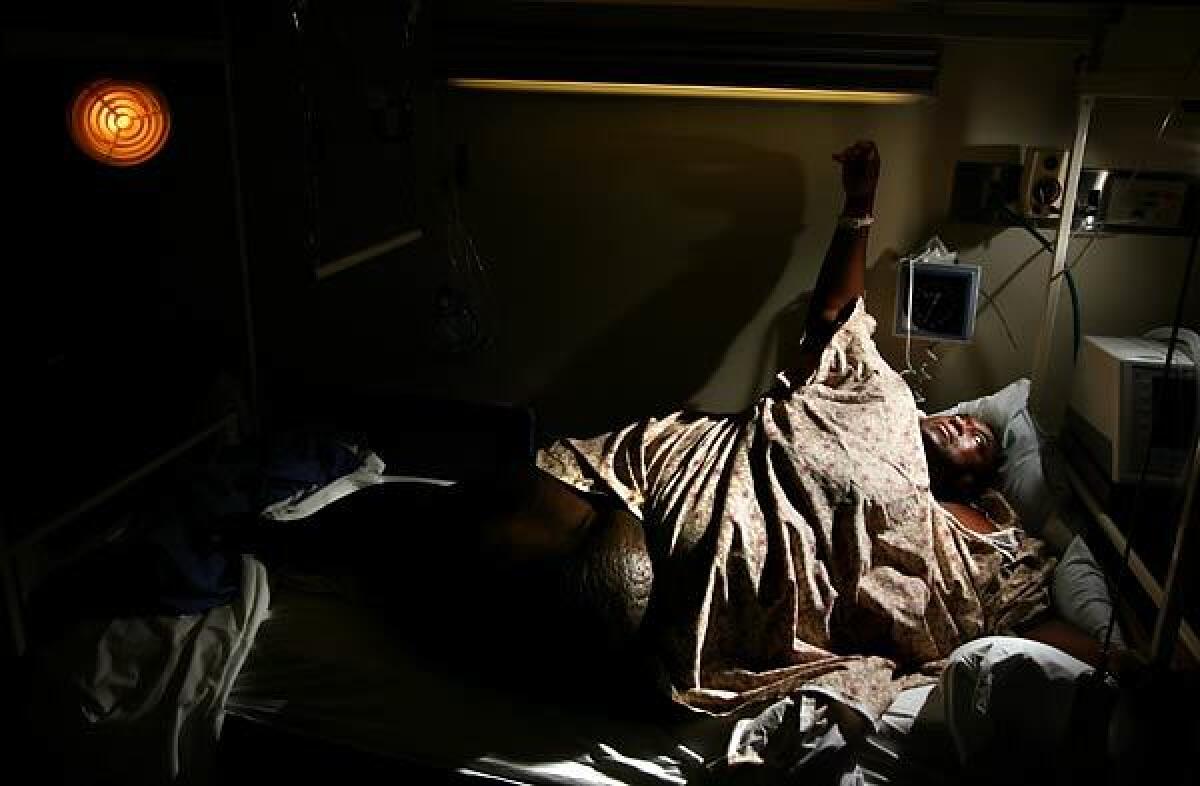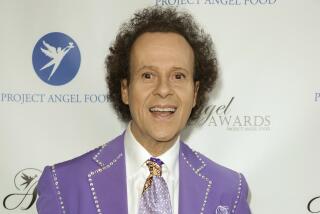A body larger than life

Billi Gordon is 6 feet 1 and weighed 701 pounds when he was admitted to Cedars-Sinai Medical Center last month. Offering directions to his room, he couldn’t resist adding, “I will be the large black man in the hospital bed.”
For most of his adult life, he has been that large black man, never denying his girth, using it to disarm and entertain, creating a theatrical comedy career -- in drag -- before pursuing research in neuroscience.
“Do you know how hard it is to go from being a legendary diva to being a brain doctor?” he asked.
Though Gordon, 55, has not ignored his size, for years he denied its consequences. Then his body stopped letting him do so.
As he sat on his bed, even a hospital gown that fell below his knees could not hide the mysterious mass that has been growing for several years from his upper right thigh. It now spreads between his legs, almost to his feet. It is a saddlebag of skin, smooth in places, dimpled in others.
“Otherwise, I have beautiful legs,” he said.
As Gordon has widened, his life has narrowed. By the end of the summer, he couldn’t fit into his red Mustang convertible. Scrubs were the only street clothes he could wear. He was too heavy even for weight-loss surgery.
He has been in and out of the hospital since late spring. His longest stay began in mid-August and lasted a month. Two days after he was released in September, he buckled at the knees and fell to the floor from the weight of the growth. He was sent back to Cedars.
“I think when he couldn’t get up and when he couldn’t walk, that was the first time I heard fear in his voice,” said his cardiologist, Walter Kerwin.
Gordon’s size makes everything more complicated -- even diagnosing his ailments. Whether the growth was a cancerous tumor (unlikely) or a glut of swollen soft tissue caused by poor lymphatic flow (probable), Gordon needed an MRI. But no MRI machine at Cedars -- or any other hospital his doctors could locate -- would hold him. The maximum weight limit of the largest MRI machine is 550 pounds.
Gordon and his medical team speculated that the Los Angeles Zoo might have one big enough. (It doesn’t. Urban myth, says the zoo’s chief vet.)
But before anyone found out for certain, Gordon took action. He began dieting -- not so much to fit into an MRI machine as to prepare for the likelihood of high-risk surgeries to remove the mass.
After a lifetime of diets and a diet pill disaster, after seeing his weight drop into the 300s and soar close to 1,000, Gordon opted for an 1,800-calorie-a-day, mostly liquid protein diet, aided by the diuretic Lasix.
He had finally reached a point where he could no longer co-opt his obesity for cleverness, for a TV role, for a funny book. He had become imprisoned by it.
“About this growth on my leg -- I’m grateful I have it,” he said recently. “And I’ll tell you why. Because it has taught me humility, and it’s taught me gratitude for things I otherwise took for granted -- sitting in my car or walking down the street.”
Gordon can outline in meticulous detail all the factors that he believes have played a part in his weight struggle -- a thyroid problem, stress, depression, a bad reaction to beta blockers, even the fact that his late mother was bipolar. “Bipolar disorder in the next generation appears as a metabolic disorder where people go from being hyperkinetic to being overly sedentary,” Gordon said.
Sometimes the problem was just too much food. “I went through a depression and gained 200 pounds,” he said of a six-month period earlier this year. “Have I made some bad food choices? I wish I had a dollar for every one I made. I could buy an MRI machine.”
But apathy, he insists, is not among his problems: “Do you honestly think if I could do anything about this, I wouldn’t?”
Gordon invites people to laugh at his jokes about his size. But he bristles if others are irreverent about him. He can leverage his presence -- physical and theatrical -- to intimidate, casting a withering glance at anyone he suspects of disrespect. He delights in recounting his first meeting with Kerwin, his now-beloved cardiologist.
“Mr. Gordon . . . “ the cardiologist began.
“It’s Dr. Gordon,” corrected his soon-to-be patient.
One day a cheerful volunteer stopped by his hospital room. As he left, he turned to one of Gordon’s visitors. “I have magazines,” the volunteer said. “Maybe you can pick some out for her later.”
Her?
Gordon smirked. “Happens all the time, honey.”
He once made a nice living off his feminine features. With his soft face and bosomy chest, he slipped easily into drag, posing for humorous greeting cards and playing loud-talking, imperious women for comic relief.
In drag, he had a small role in an episode of “Married With Children” and appeared in the Eddie Murphy comedy “Coming to America.” As a writer, he penned an episode of the late-’80s sitcom “227” and several humor books. (“Eat This Book: The Last Diet Book” featured Gordon on the cover in a black strapless dress, with one hand on a cocked hip.)
When Gordon and his partner married in a ceremony 21 years ago, Gordon wore a long white wedding gown and a wide-brimmed hat.
“He was always strictly in drag,” said Gordon’s husband, an intensely private man who asked not to be named. “It was very convincing. There are people who still think he’s a woman,” he said, laughing.
Gordon’s husband is 45, about 5 foot 9 and weighs 150 pounds.
He says of Gordon, “I accept him for all he is.”
Still, over the years he tried everything, including locks on the refrigerator, to stop Gordon’s weight -- 400 pounds when they married -- from ballooning.
He said he doesn’t expect Gordon to get thin, just lighter:
“My greatest hope for him would be to lose weight that would free him. He can’t get to places he needs to go to, he can’t get to places where he wants to go. He has this synthetic life -- it’s TVs and computers and a room. It wasn’t like this before.”
Gordon grew up in tiny Dowagiac, Mich., a “happy fat boy,” weighing around 300 pounds in high school. At the University of Michigan, he became addicted to the diet pill Preludin -- now off the market -- and slipped down to 172 pounds. He fled Ann Arbor before graduating, his thinking addled by the drug, he says, and aimlessly drove to South Dakota and then on to L.A.
“OK, this epitomizes how naive I was: I decided I would go to California to get off drugs,” he said. “I’m extremely lucky. Just like I woke up on a back road in South Dakota, I could have awakened in Jeffrey Dahmer’s apartment wearing a bun and lettuce.”
His life in Los Angeles, as he tells it, was tumultuous. He worked as an escort, a male prostitute, a female prostitute -- in that order. It wasn’t until the mid-80s that he discovered his talent for comic writing and performing as a woman.
In the mid-’90s, he finished the course work for his bachelor’s degree at Michigan. He also returned to being a man -- womanly primping, he jokes, took too much time away from studying -- and went on to earn a doctorate in 2004 from Union Institute & University, a nontraditional school geared toward adult, working students doing independent study. His degree was in arts and sciences, with a concentration in integrative behavioral neuroscience.
“He is so outgoing, friendly, loving beyond belief,” said Mark Cohen, a neuroscientist and professor of psychiatry at UCLA School of Medicine, who supervised Gordon’s post-doctoral work. “He brings in a perspective that has been interesting in the lab.” Cohen urged him to lose weight. “I’ve told him so many times that this is near-suicidal.”
After working in Cohen’s lab, Gordon became a researcher at the UCLA Center for Research, Education, Training, and Strategic Communication on Minority Health Disparities. He did most of the work from home on his computer. When the grant that paid him ran out, the jobs available at UCLA would have required his presence on campus -- an impossibility, he says.
Gordon’s doctors have tried to find ways to shrink the growth without surgery. They even looked into liposuction. But ultrasound images -- the best they can get without an MRI -- indicate that the mass is a patchwork of tissue and fluid that can’t be drained. “He is literally like a sponge,” said Amy Weinberg, his longtime internist. So the likely option is surgery at some point.
The mass is just one of the hazards of his morbid obesity.
“It wouldn’t take much to make him really, really sick or for him to die,” Weinberg said. “So I spend a lot of time worrying about him and trying to think of things we can do. He’s constantly on my mind.”
She chuckled. “He’ll love hearing that.”
Twelve days after returning to Cedars in September, Gordon had dropped 99 pounds -- give or take 10 or 20 or 30 pounds. Weighing him in his bed is an inexact science.
After two weeks, he was discharged once again and returned to his modest home in Mar Vista, still hooked up to intravenous antibiotics.
His first full day home, he grew depressed. “I just started calling people and said, ‘I’m scared and lonely, come talk to me.’ ”
He took this as a positive sign. “I would never have done that in the past. I would have said, ‘Hello, Domino’s? What’s your special?’ And I would have grabbed a jar of pickles and eaten them all. And drunk the juice. And I didn’t do that. Because I’m not giving up my life to this.”
After two days home, he got out of bed in his Tiffany blue room and stood on his scale. He weighed 583 pounds. Last week he replaced the liquid diet with a regimen of lean protein, fruits and vegetables.
He has plans. He wants to raise money for his own research, and he hopes to finish his memoir.
“Yes, I was in denial. It was a psychic survival mechanism. But I’m not in denial now,” he said. He can walk again now. He gets out of bed, draped in a hospital gown, and strides easily through the house. As soon as he reaches the front porch, he is winded. Still, it’s progress.
“Before I went to the hospital, I had to use the walker to get out of the bedroom,” he says. “There was no freestyle walking, as I call it. Now there is.”
Last Thursday, Gordon weighed 532 pounds. Weinberg began trying to schedule his MRI. On Saturday, he fit into his car. He texted, “Triumph city!!” Then he drove to the beach.
More to Read
Start your day right
Sign up for Essential California for news, features and recommendations from the L.A. Times and beyond in your inbox six days a week.
You may occasionally receive promotional content from the Los Angeles Times.







